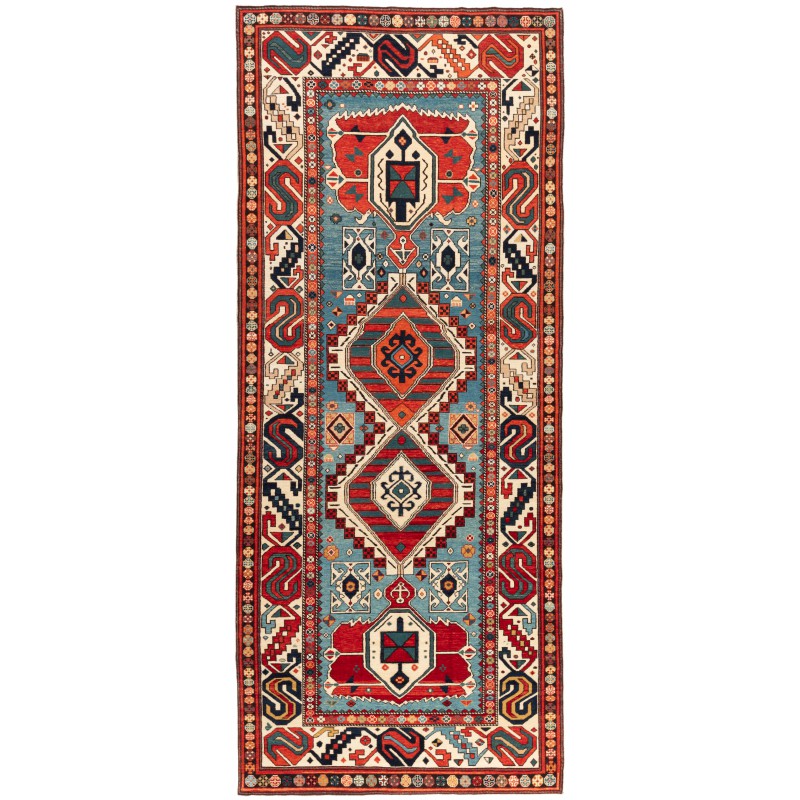
- Stock: In Stock
- Model: C50026
- サイズ: 128cm x 303cm
この絨毯の情報源は、Ian Bennett著の『Oriental Rugs Volume 1 Caucasian』(Oriental Textile Press, Aberdeen 1993)の第256号です。これは19世紀末のシルヴァン地域(コーカサス地域)の六角形の柱の絨毯です。これは、一列に配置された段差のある六角形のモチーフを持つ、よく知られたシルヴァン絨毯の構成を表しています。列の両端には平らで鋸状のメダリオンがあります。一部の著者は、後者のモチーフを古代エジプトやペルシャの王の紋章に関連付けています。例えば、Raymond Benardoutの『Caucasian Rugs』(p.51)に掲載されているようないくつかの例では、大きな鋸状のメダリオンが一列に配置され、その中心には小さな六角形があります。一般的には、これらの絨毯は、クバの南部地域のいわゆる「ゼジワ」絨毯との類似性によって証明されました。しかし、コーカサスの織物に関する一般的な説明は、いくつかの例外があります。たとえば、Murray Eilandの『Oriental Rugs』(no.159)に掲載されている白い綿糸で仕上げられた綿経の一例、Richard Purdonの『Shirvan and related Weavings from the North Caucasus』(no.2とno.3)に掲載されている同様の構造の二つの例、およびPeter Bausbackの1976年のカタログ(p.89)に掲載されている青い綿糸で仕上げられた綿経の絨毯などがあります。これらの絨毯は、ほとんどが濃い青のフィールドに、動物、鳥、人物のモチーフを含むさまざまな装飾が施されています。黄地のボーダーにはリンクした「S」のモチーフがよく見られるボーダーであり、このボーダーは北ペルシャの部族や村の絨毯でも見られます。このタイプの最初の例は、オーストラリアアンティークラグ協会の1974年のカタログ『Antique Rugs from the Caucasus』(no.13)に掲載されており、1902年とされていますが、私は1304 A.H.(1886/7年)という読み方を好みます。このタイプの2番目の日付付きの例は最近、イギリスの地方オークション(Elliott and Green, Lymington, 1979年6月28日、ロット363)で見つかりました。これには特定のフィールドと「インターロック」ボーダーの構成があり、私たちの261とも類似しており、1333 A.H.(1914年)と日付が付けられており、合成のオレンジ色とピンク色がわずかに使用されていますが、非常に良質です。現在の絨毯は、メトロポリタン美術館(Dimand, no. 174)やシュルマンの著書(no.66)の例に非常に似ています。この絨毯のデザインは、私たちのデザイナーによって解釈され、オリジナルに合う最適な色が使用されています。
The source of the rug comes from the book Oriental Rugs Volume 1 Caucasian, Ian Bennett, Oriental Textile Press, Aberdeen 1993, nr.256. This is a hexagon columns rug from the late 19th century, Shirvan region, Caucasus area. This represents a well-known type of Shirvan carpet composition which has rows of stepped-edged and conjoined hexagonal motifs arranged in a single vertical row, with a flattened, saw-edged medallion at either end of the row; some authors have related the latter motif to ancient Egyptian and Persian Royal insignia. Some examples, such as that illustrated in Raymond Benardout’s Caucasian Rugs (p.51), large saw-edged medallions are found in a single vertical row, with small hexagons at their centers. In general, the idea was borne out by their resemblance to so-called ‘Zejwa’ rugs from the area south of Kuba. As with all generalizations about Caucasian weavings, however, there are numerous exceptions-for instance the cotton-weft piece with white cotton overcast sides illustrated in Murray Eiland’s Oriental Rugs (nr.159), the two examples with similar structure in Richard Purdon’s Shirvan and related Weavings from the North Caucasus (nr. 2 and 3), and the cotton-weft rug with blue cotton overcasting illustrated in Peter Bausback’s 1976 catalog (p.89). These rugs almost all have dark blue fields with myriad filler ornaments including animals, birds, and human figures; a yellow-ground border with linked ‘S’ motifs is a commonly found-a border which, both in color and design, is also found in north Persian tribal and village rugs (cf. Jenny Housego, Tribal Rugs, pl. 82). The first is illustrated in the Australian Society for Antique Rugs’ 1974 catalog, Antique Rugs from the Caucasus (no. 13), with the date read as 1902, although I prefer the reading 1304 A.H. (A.D. 1886/7). The second dated example of this type came to light recently in a provincial auction in England (Elliott and Green, Lymington, 28 June 1979, lot 363); this had the specific field and ‘interlock’ border composition, also similar to our 261, was dated 1333 A.H. (A.D. 1914) and was of very good quality apart from the albeit sparing use of synthetic orange and pink. The present rug is very similar to examples in the Metropolitan Museum (Dimand, no. 174) and in Schürmann’s book (no. 66). The design of the rug is interpreted by our designers, and the most appropriate colors to match the original is used for this rug.
